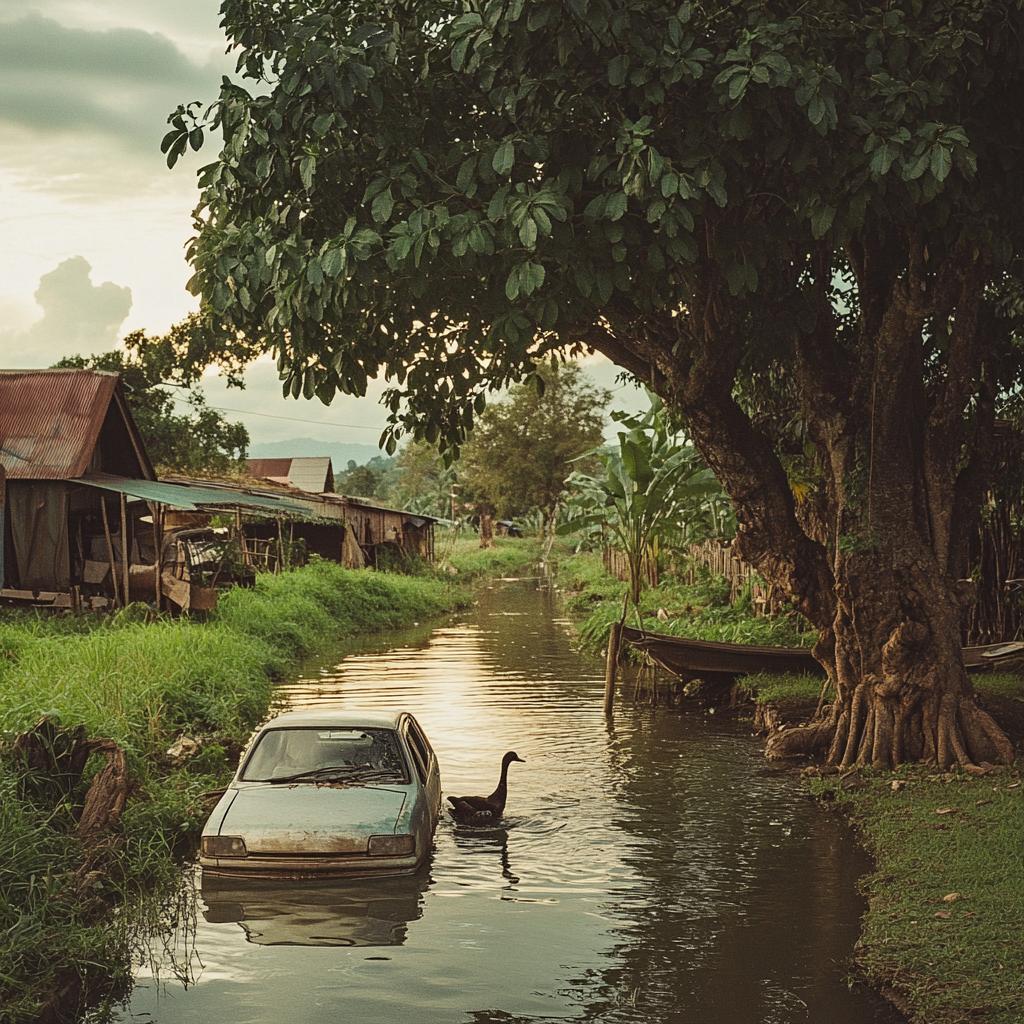On a seemingly ordinary afternoon, a heart-wrenching incident unfolded in the picturesque Sainoi district of Nonthaburi province. It was a day that would forever be etched in the memories of those involved, and the events that transpired seemed more like the plot of a gripping novel than real life.
The tale begins with a retired teacher named Phuttipong, a man devoted to his family and well-liked by those who knew him. On March 24, as the clock struck 4 PM, Phuttipong embarked on what was intended to be a routine journey. Driving his trusty Toyota Fortuner, he set off to pick up his beloved wife from Suvarnabhumi International Airport. She had just returned from visiting their daughter in Cambodia—a family reunion that was meant to culminate in joyful exchanges and loving embraces.
However, fate had a different plan. As Phuttipong and his wife headed towards Suphan Buri province, their vehicle suddenly spiraled out of control. The peace of the countryside was shattered by the sound of screeching tires, as the Fortuner veered off Road 340, skidding across the bridge and plummeting into the Khlong Lat Thawi Phon canal.
Thankfully, amidst the chaos, a local hero emerged. A duck farmer by the name of To, only 25 years old, was nearby with his little brother, seeking refuge from the midday sun beneath a jujube tree. The sudden crash stirred To into action. He wasted no time in diving into the murky canal waters, driven by instinct and a heart full of bravery.
Reaching the now partially submerged vehicle, To spotted Phuttipong’s wife trapped in the passenger seat. With sheer determination, he freed her from the wreckage, coaxing her to the safety of the canal’s bank. Though shaken and injured with a cut on her neck and an open wound on her chin, she remained conscious, pleading with To to save her husband.
To’s valiant efforts continued as he struggled to dislodge Phuttipong, hampered by the stubborn seatbelt. Tragically, by the time To managed to extract him, Phuttipong’s injuries proved insurmountable, and he succumbed at the scene. The river’s depths had claimed him, leaving his wife to be rushed to Sainoi Hospital, with hope and healing in mind.
The aftermath of this heartbreaking accident was overseen by Police Lieutenant Dechrith Saengjunsri, who coordinated with forensic specialists and dedicated rescue teams from the Ruamkatanyu Foundation. The scene revealed more than just the sunken vehicle; it told a story of lost opportunities, unspoken words, and a future abruptly altered. Authorities determined that a lack of brake marks suggested Phuttipong may have nodded off at the wheel, rendering the tragedy a result of fatigue’s cruel clockwork.
Phuttipong’s family, stricken by grief, now faces the harrowing task of accepting what they can’t change. With legal procedures in motion, the deceased teacher’s body was scheduled for further examination before being returned for traditional rites—rituals that would pay homage to a life lived with kindness and compassion.
This tale, while heavy with sorrow, is also a testament to human courage and the unexpected ways in which heroes are born. To, the duck farmer, epitomizes the spirit of selflessness. He is a reminder that in times of darkness, there will always be those willing to dive into danger, with nothing more than a glimmer of hope and a heart full of courage.


















What a tragic story! But it’s amazing to see someone so selfless like To step up to help. It’s sad the man didn’t survive though.
To’s actions were incredible, but it’s frustrating how preventable this seemed—fatigue is such a silent killer.
Totally agree. More awareness on driver fatigue could save lives. People underestimate how dangerous it is.
But can you really blame him? It’s hard for people to know when they’re going to fall asleep, especially on a long drive.
I wonder if the lack of emergency services onsite contributed to the tragedy. Faster response could have made a difference.
Amazing heroism by To! But did anyone consider therapy or support for him? Imagine how traumatic it must be to try saving someone and failing.
Such a heartbreaking story. Makes me wonder if natural settings like canals are really safe for roads to intersect with!
There are plenty of places that deal with this. The issue comes down to road safety and driver alertness.
Agreed. Proper barriers and road designs can prevent these accidents. We need better infrastructure.
Phuttipong’s story reminds me of why it’s essential to always tell your loved ones how much they mean to you.
This story also raises the issue of how much responsibility should be placed on drivers versus infrastructure.
I can’t help but think of the wife’s trauma. Surviving the crash but losing your beloved one must be the worst kind of pain.
She’ll probably need a lot of emotional and psychological support. I hope the community rallies around her.
Is it possible to reward To for his bravery? People like him deserve recognition.
There should be initiatives for civilian bravery awards. They highlight acts of courage and encourage the rest of us.
Exactly, it’s vital that his efforts don’t go unnoticed.
They mentioned a lack of brake marks which means Phuttipong might’ve nodded off. Could automated braking systems prevent tragedies like this?
Although To was a hero, it’s a pity he couldn’t save them both. Sometimes bravery isn’t enough against fate’s cruel hand.
With self-driving tech advancing, shouldn’t we expect fewer accidents from human errors? Perhaps in the future?
Back in my day, we were taught never to drive tired. More awareness and education go a long way.
Could planting more trees or vegetation along roads help in providing natural deterrence? Nature could be an ally in preventing these tragedies.
Nonthaburi is such a beautiful place. It’s a shame this tragedy mars the beauty but also highlights the community spirit.
This is a reminder to be vigilant while traveling in other countries, and to be aware of local road conditions.
I hope the authorities investigate comprehensively and any steps taken to prevent recurrence. These aren’t just accidents; they’re tragedies that demand action.